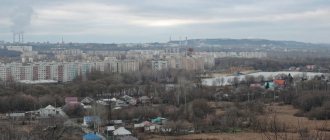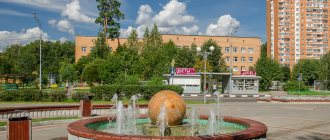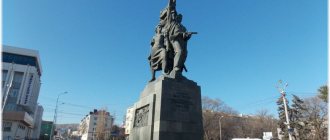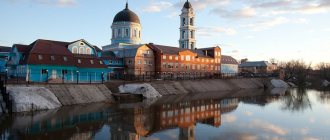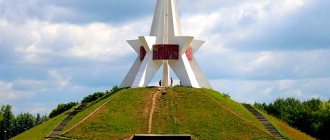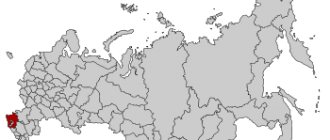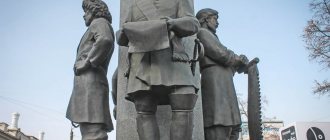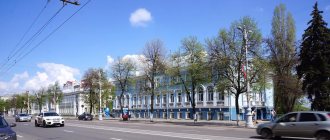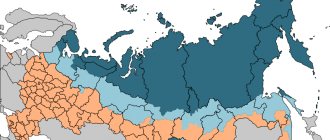Finally, I got to the story about our summer trip to the Pskov region. And today - the first of them, about the city of Rzhev, located in the Tver region. We got to Rzhev while passing through, on the road to Velikiye Luki. Actually, initially we didn’t even intend to go there, but since we were passing by, why not spend a few hours on it? And they didn’t regret it.
Volga and the "Old" bridge
Brief historical background
Rzhev is an ancient city. It was first mentioned in written sources (Novgorod Charter) in 1019; there is also a later date - 1216. There is no clear opinion among historians yet. Later it was part of the Principality of Toropets, and from 1225 it became the center of the appanage Principality of Rzhev. At the beginning of the 14th century, Rzhev entered the Moscow Principality. Then there was a period as part of the Tver and Lithuanian principalities, and in 1526 it finally went to Moscow and lost all sovereign rights. Later it was included in the Novgorod and then Tver provinces.
Rzhev suffered seriously during the Great Patriotic War. In the famous Battle of Rzhev, which lasted from January 1942 to March 1943 and included four offensive operations, the permanent losses of Soviet troops amounted, according to various estimates, to more than 400,000 people. Of the 20 thousand people who found themselves under occupation, on the day of liberation, March 3, 1943, only 150 people remained alive, together with the region - 362 people. Of the 5,443 residential buildings in Rzhev, only 297 survived... It is not surprising that in Rzhev there are many reminders of the war.
When is it better to attack: the logic of war
The battle for Rzhev became one of the most controversial, classified and even mysterious episodes of the Great Patriotic War. Only by chance and the power of A. Tvardovsky’s talent did the whole country learn the words “I was killed near Rzhev.” What happened in the area of the Rzhev salient? It would seem that this is not the time to attack: in the south, German units are rushing to the oil fields of the Caucasus, in the large bend of the Don on the far approaches to Stalingrad a tank battle is dying out. If somewhere the enemy is not conducting offensive actions, then it’s time to sit quietly and improve your defense.
Map of the battle for Rzhev
Source: upload.wikimedia.org
However, war has a completely different logic. Firstly, now that it is possible to get acquainted with the documents of both sides, the thesis “does not conduct offensive actions” becomes completely unconvincing. On the one hand, the strongest Army Group Center did not receive tasks as part of the Blau plan of the Wehrmacht's summer offensive. Here the Germans simulated preparations for an attack on Moscow - the so-called Operation Kremlin. It would be a big mistake to think that instead of this imitation, the Germans could not have carried out an offensive of limited scale, but with dire consequences for the Soviet troops.
The commander of Army Group Center, von Kluge, chose the Sukhinichi ledge, formed during the Soviet winter offensive of 1941-1942, as the target of capture. The name “Kremlin” would have been too strong for such an offensive, and the operation was codenamed “Smerch” (Wilberwind). Initially, the start of “Smerch” was scheduled for August 7-9, 1942. The plan provided for strikes in converging directions, typical of the German military school, with the aim of encircling Soviet troops in a bulge. A kind of Kursk Bulge of 1943, but on a reduced scale. The staff worked on this plan for several months. If Army Group Center had become the main player in the 1942 campaign, then the attack on Moscow would have begun with the cutting off of the Sukhinichi ledge.
Secondly, the Soviet General Staff and the headquarters of the Kalinin and Western fronts did not know all this at that time, but were preparing for an offensive with their own goals. The tasks of the Kalinin and Western Fronts were formulated in the Directive of the Supreme Command Headquarters No. 170514 of July 16, 1942. It said, in particular: “...with the main forces to capture the city of Rzhev, crossing the river. Volga and the railway junction." The Germans, holding Rzhev, controlled the highways and railways on the flank of Army Group Center. To push the Germans further from Moscow, it was necessary to effectively supply the Kalinin Front, which hung over the flank of Army Group Center. Without Rzhev this would have been impossible. In addition, by knocking the Germans out of their positions near Rzhev, the Red Army deprived the enemy of an advantageous springboard for an attack on Moscow. Now we know that Moscow was not in the Wehrmacht’s immediate plans. It is not difficult to predict how the situation would turn out if Blau were successful. Moscow would undoubtedly become one of the next targets of the German war machine.
Soviet soldiers in the battles for Rzhev
Source: pinterest.ru
Returning to the end of July and the first days of August 1942, it should be said that the Soviet offensive was unexpected for the Germans. At least in terms of the strength of the blows and the effectiveness of his preparation. Despite the overall difficult situation with ammunition in 1942, significant resources were allocated for the attack on Rzhev, primarily artillery (Stalingrad, as a maneuver battle, absorbed mainly tank reserves).
By the end of the first day of the offensive, the troops of the 30th Army broke through the defenses of the 256th and 87th Infantry Divisions of the German VI Army Corps on a front of 9 km and to a depth of 6-7 km. There were 6 kilometers left to Rzhev. However, covering these kilometers took a month. The problem with Rzhev and other positional battles was that if it was not possible to immediately collapse the front and bring tanks into the breakthrough, the enemy pulled up reserves to the attacked area and built a new line of defense. The mechanism for the development of events was absolutely identical to the battles of the First World War, which took place not due to the stupidity of the participants, but due to objective problems in crushing a strong and capable enemy. When neither side has a decisive advantage in forces and means.
A short walk around Rzhev
Having driven around the city, we stopped at Sovetskaya Square . It is traditional for many Russian cities: a monument to Lenin , attractions.
Monument to Lenin on Sovetskaya Square Stela “Rzhev - City of Military Glory”
Nearby are ancient houses that now house government agencies.
Branch for the Rzhevsky district of the Federal Treasury Department for the Tver region
Police Department
Not far from Sovetskaya Square there is a park by V.V. Gratsinsky (1891-1918), laid out in honor of the first military commissar of Rzhev district. There are many monuments dedicated to Soviet history.
Park named after V.V. Gratsinsky
Monument to executed underground fighters
Gracinsky's grave still bears traces of shells.
Monument at the grave of V.V. Gratsinsky
Monument at the grave of V.V. Gratsinsky
Monument at the grave of V.V. Gratsinsky
From Gratsinsky’s grave there is an Alley of Heroes of the Soviet Union, participants in the Battle of Rzhev . Pedestals with names were chosen by pigeons, which are absolutely not afraid of people.
Alley of Heroes of the Soviet Union - participants in the Battle of Rzhev
Pigeons
Having passed through the park, we came out onto a high slope. Below, the Volga winds like a picturesque ribbon. Rzhev is the first city on the Volga; it is located 200 km from its source.
"Old" bridge and the Volga river Volga and "New" bridge
Volga and the Church of the Icon of the Mother of God of Okovets in Rzhev
There are also many monuments dedicated to the Great Patriotic War*.
* At first I wanted to write “dedicated to the last war.” But, alas, that bloody war was not the last...
Monument - ZIS-2 anti-tank gun
A little further away is the Obelisk to the Heroes of the Great Patriotic War , erected in 1963, in honor of the 20th anniversary of the end of the Battle of Rzhev.
Bridge and obelisk in honor of WWII heroes
The newlyweds' permanent locks are on the pedestrian bridge.
Locks
Obelisk to the heroes of WWII
Bas-relief on the pedestal of the obelisk to the heroes of the Second World War
Next to the Obelisk is the eternal flame at the Tomb of the Unknown Soldier .
Tomb of the Unknown Soldier
On the other side of Gratsinsky Park is the red Church of the New Martyrs and Confessors of Russia , founded on May 8, 1995; Services have been held here since 2004.
Church of the New Martyrs and Confessors of Russia
On the other bank of the Volga there are several more interesting monuments. Noteworthy is the majestic Cathedral of the Icon of the Mother of God of Okovets, built in 1821, with the thrones of John the Baptist and Nil Stolobensky.
Cathedral of the Icon of the Mother of God Okovetskaya
Not far from it you can see the Memorial Complex to fallen internationalist soldiers and participants in other local conflicts .
Memorial complex to fallen internationalist soldiers and participants in other local conflicts
Control machine in the Memorial complex to fallen internationalist soldiers and participants in other local conflicts
After admiring the city, we hit the road.
The Germans have to change all their plans!
Events developed in the offensive zone of the Western Front according to a similar scenario. Already at 13:50 on the first day of the offensive, units of the 251st Infantry Division of the 20th Army broke into Pogoreloe Gorodishche. As a result of fierce fighting, which turned into hand-to-hand combat, the garrison of Pogorely Gorodishche, while trying to break through the bridge on the Derzha River at the southwestern outskirts of the city, was partly destroyed and partly captured. Subsequently, the operation will receive the name “Pogorelo-Gorodishchenskaya” after the name of this city liberated by the 20th Army. The Rzhev area was then the only place on the Soviet-German front where the Red Army advanced and liberated the territory.
In moments of calm
Source: pinterest.ru
As a result of two days of operation, the troops of the 20th Army broke through the enemy’s defenses on a front of 18 km and to a depth of 30 km and advanced units reached the approaches to the Vazuza and Gzhat rivers. Here the Soviet offensive was stopped by hastily gathering reserves. Where did they come from? The Germans abandoned the offensive on the northern face of the Sukhinichi ledge. “Smerch” in its original form is cancelled, three tank divisions are quickly moving towards the 20th Army. The front is gradually recovering. The last success on the Western Front was the destruction of a large German stronghold near the village of Karmanovo on August 23, 1942. One of the reasons for the loss of momentum was also the heavy rains that poured in on August 7, which significantly hampered the supply of advanced units along washed-out roads.
On August 26, 1942, the commander of the Kalinin Front, I.S. Konev, was appointed commander of the Western Front, replacing G.K. Zhukov, who assumed the post of Deputy Supreme Commander-in-Chief and hastily left for Stalingrad. Lieutenant General M.A. Purkaev was appointed commander of the Kalinin Front. However, I.S. Konev did not leave the battle for Rzhev.
Sights of Rzhev
- Memorial military cemetery: Rzhev, Ostashkovskoe highway
- Izba-museum of J.V. Stalin: Khoroshevo village, tel. 8 (48232) 79 203
- Steam locomotive - a monument to Rzhev railway workers: st. Mira, 8
- Museum of Military History of Rzhev: Krasnoarmeyskaya embankment, 26
- Rzhev Museum of Local Lore: Krasnoarmeyskaya embankment, 24a; Opening hours: from 11.00 to 18.00, except Monday (on Tuesday only excursion service)
- Rzhev branch of the Central Museum of the October Railway: st. Oktyabrskaya, 74/21
- Church of the Okovets Icon of the Mother of God: st. Marata, 2
- Church of the New Martyrs and Confessors of Russia: st. Lenina, 2
- Ascension Cathedral: Toropets tract
- Bell tower of the Church of the Life-Giving Trinity: st. Smolnaya
- Church of the Intercession: st. Kalinina, 62
© Website “On the Roads of the Middle Way”, 2009-2021. Copying and reprinting of any materials and photographs from the site anashina.com in electronic publications and printed publications is prohibited.
